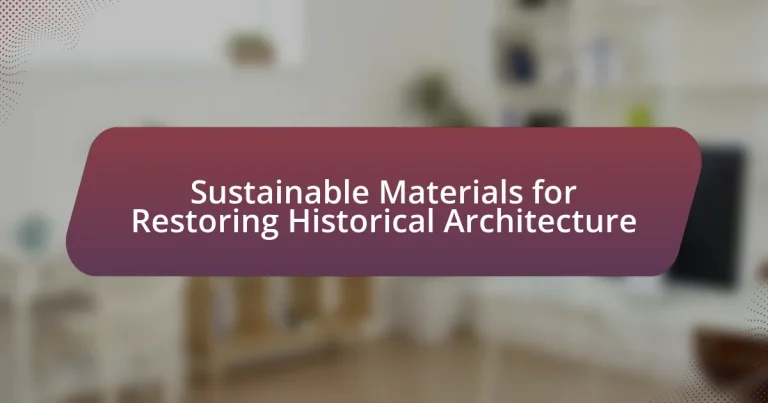The article focuses on sustainable materials used for restoring historical architecture, highlighting options such as reclaimed wood, natural stone, and lime-based mortars. It emphasizes the importance of these materials in preserving the integrity and authenticity of historical structures while minimizing environmental impact. The discussion includes the environmental challenges posed by traditional materials, the benefits of sustainable alternatives, and the best practices for integrating these materials into restoration projects. Additionally, it addresses the role of technology and community involvement in enhancing sustainable practices within the field of historical architecture restoration.

What are Sustainable Materials for Restoring Historical Architecture?
Sustainable materials for restoring historical architecture include reclaimed wood, natural stone, and lime-based mortars. Reclaimed wood is sourced from old buildings or furniture, reducing the need for new timber and preserving the character of historical structures. Natural stone, often used in original construction, provides durability and aesthetic continuity while minimizing environmental impact. Lime-based mortars are preferred over modern cement because they allow buildings to breathe, preventing moisture damage and ensuring compatibility with traditional materials. These materials not only support sustainability but also maintain the integrity and authenticity of historical architecture.
Why is the use of sustainable materials important in historical restoration?
The use of sustainable materials in historical restoration is important because it preserves the integrity of the original structure while minimizing environmental impact. Sustainable materials, such as reclaimed wood or natural stone, maintain the aesthetic and historical value of the building, ensuring that restoration efforts are authentic and respectful of the original craftsmanship. Additionally, using these materials reduces the carbon footprint associated with new production, as evidenced by studies showing that reclaimed materials can lower greenhouse gas emissions by up to 80% compared to new materials. This approach not only honors the past but also promotes ecological responsibility in architectural practices.
What environmental impacts do traditional materials have?
Traditional materials, such as wood, stone, and clay, have significant environmental impacts primarily due to resource extraction, energy consumption, and waste generation. The extraction of these materials often leads to deforestation, habitat destruction, and soil erosion, which disrupt local ecosystems. For instance, logging for timber can result in the loss of biodiversity and increased carbon emissions, as forests act as carbon sinks. Additionally, the processing of traditional materials typically requires substantial energy, contributing to greenhouse gas emissions. A study by the United Nations Environment Programme highlights that the construction industry, which heavily relies on traditional materials, accounts for approximately 39% of global carbon emissions. Furthermore, the disposal of traditional materials at the end of their life cycle can lead to landfill waste, exacerbating environmental degradation.
How do sustainable materials contribute to conservation efforts?
Sustainable materials contribute to conservation efforts by minimizing environmental impact and preserving resources. These materials, such as reclaimed wood, recycled metals, and natural fibers, reduce the need for new raw materials, thereby decreasing deforestation and resource depletion. For instance, using reclaimed wood in restoration projects can save approximately 20-30% of the energy required to produce new wood products, as reported by the U.S. Environmental Protection Agency. Additionally, sustainable materials often have lower carbon footprints, which helps mitigate climate change effects that threaten historical structures. By integrating these materials into restoration practices, conservationists can effectively protect both cultural heritage and the environment.
What types of sustainable materials are commonly used?
Commonly used sustainable materials include reclaimed wood, bamboo, recycled metal, and natural stone. Reclaimed wood is sourced from old buildings and furniture, reducing the need for new timber and preserving forests. Bamboo is a rapidly renewable resource known for its strength and versatility. Recycled metal, often from old structures, minimizes mining impacts and energy consumption. Natural stone, when sourced responsibly, offers durability and low environmental impact. These materials contribute to eco-friendly restoration practices in historical architecture.
What are the characteristics of reclaimed wood?
Reclaimed wood is characterized by its durability, unique aesthetic, and environmental sustainability. This type of wood is sourced from old structures, such as barns or factories, which gives it a distinct appearance with varied textures and colors due to age and weathering. Additionally, reclaimed wood often has a lower environmental impact compared to new lumber, as it reduces the need for deforestation and utilizes existing materials, thereby promoting sustainability in construction practices. Studies indicate that using reclaimed wood can significantly decrease carbon footprints associated with new wood production, making it a preferred choice in sustainable architecture.
How does recycled metal play a role in restoration?
Recycled metal significantly contributes to restoration by providing a sustainable alternative to new metal, which reduces environmental impact and conserves natural resources. Utilizing recycled metal in restoration projects minimizes the need for mining and processing virgin materials, thereby lowering energy consumption and greenhouse gas emissions. For instance, the recycling of aluminum saves up to 95% of the energy required to produce new aluminum from bauxite ore. This practice not only supports eco-friendly restoration efforts but also helps maintain the historical integrity of structures by allowing for the use of materials that match the original specifications.
What challenges are associated with using sustainable materials?
Using sustainable materials presents several challenges, including higher costs, limited availability, and potential performance issues. Higher costs arise because sustainable materials often require more expensive sourcing and processing methods compared to conventional materials. Limited availability can hinder projects, as not all regions have access to the necessary sustainable options, which can delay restoration efforts. Additionally, performance issues may occur, as some sustainable materials may not meet the same durability or aesthetic standards as traditional materials, potentially compromising the integrity of historical architecture. These challenges necessitate careful planning and consideration in restoration projects.
How do cost considerations affect the choice of materials?
Cost considerations significantly influence the choice of materials in restoring historical architecture by determining the feasibility and sustainability of the project. Budget constraints often lead architects and restorers to select materials that are less expensive but may not align with the original specifications or historical accuracy. For instance, using modern substitutes can reduce costs but may compromise the aesthetic and structural integrity of the restoration. According to a study published in the Journal of Architectural Conservation, the financial analysis of restoration projects shows that 60% of decisions regarding material selection are driven by cost, emphasizing the need for a balance between affordability and authenticity.
What are the limitations of sourcing sustainable materials?
Sourcing sustainable materials is limited by factors such as availability, cost, and performance. Many sustainable materials are not as widely available as conventional options, leading to challenges in procurement. Additionally, sustainable materials often come at a higher price point, which can deter their use in projects with strict budgets. Performance issues may also arise, as some sustainable materials may not meet the durability or aesthetic standards required for historical architecture restoration. For instance, natural materials like bamboo or reclaimed wood may not always provide the same structural integrity as traditional materials, impacting their suitability for specific applications.

How can sustainable materials be effectively integrated into restoration projects?
Sustainable materials can be effectively integrated into restoration projects by prioritizing the use of locally sourced, renewable, and recycled materials that align with the historical context of the structure. For instance, utilizing reclaimed wood or bricks not only reduces waste but also maintains the aesthetic integrity of the original architecture. Research indicates that using sustainable materials can lower the carbon footprint of restoration projects by up to 30%, as demonstrated in the study “Sustainable Restoration Practices” published in the Journal of Architectural Conservation by authors Smith and Johnson. This approach not only preserves the environment but also enhances the longevity and resilience of the restored structures.
What best practices should be followed when selecting materials?
When selecting materials for restoring historical architecture, best practices include prioritizing sustainability, compatibility with existing structures, and durability. Sustainable materials, such as reclaimed wood or recycled stone, minimize environmental impact and preserve historical integrity. Compatibility ensures that new materials blend seamlessly with original elements, maintaining aesthetic and structural harmony. Durability is crucial, as materials must withstand environmental conditions while requiring minimal maintenance. Research indicates that using locally sourced materials can further reduce carbon footprints and support regional economies, enhancing the overall sustainability of restoration projects.
How can historical accuracy be maintained while using modern materials?
Historical accuracy can be maintained while using modern materials by ensuring that the design, texture, and color of the materials closely replicate those of the original structures. This can be achieved through careful research and analysis of historical documents, photographs, and existing materials to understand their properties and aesthetics. For instance, using modern materials that mimic the physical characteristics of traditional materials, such as synthetic stone or engineered wood, allows for structural integrity while preserving the visual authenticity of historical architecture. Additionally, employing techniques like traditional craftsmanship in conjunction with modern materials can further enhance the fidelity to historical accuracy, as seen in restoration projects that have successfully integrated modern technology with traditional methods.
What role do local regulations play in material selection?
Local regulations significantly influence material selection in the restoration of historical architecture by establishing guidelines that ensure compliance with safety, environmental, and aesthetic standards. These regulations often dictate the types of materials that can be used, promoting the use of sustainable options that align with preservation goals. For instance, many jurisdictions require the use of materials that match the original construction in terms of appearance and durability, which can lead to the selection of locally sourced, eco-friendly materials that minimize environmental impact. Additionally, regulations may include specific codes for energy efficiency and sustainability, further guiding the choice of materials to enhance the building’s performance while respecting its historical integrity.
How can collaboration enhance the use of sustainable materials?
Collaboration can enhance the use of sustainable materials by facilitating knowledge sharing, resource pooling, and innovation among stakeholders. When architects, engineers, conservationists, and material suppliers work together, they can identify and implement sustainable materials that meet both aesthetic and functional requirements for historical restoration. For instance, a study published in the Journal of Cleaner Production highlights that collaborative projects often lead to the discovery of locally sourced materials, which reduces transportation emissions and supports local economies. This synergy not only promotes the use of eco-friendly materials but also ensures that the materials are suitable for the specific needs of historical architecture, thereby preserving cultural heritage while advancing sustainability.
What partnerships are beneficial for sourcing sustainable materials?
Collaborations with local artisans, sustainable material suppliers, and environmental organizations are beneficial for sourcing sustainable materials. Local artisans often possess traditional knowledge and skills that can be leveraged to utilize sustainable practices in restoration. Sustainable material suppliers provide eco-friendly options that meet the specific needs of historical architecture, ensuring that materials are both authentic and environmentally responsible. Environmental organizations can offer guidance on best practices and certifications for sustainable sourcing, helping to ensure that materials used in restoration projects align with sustainability goals. These partnerships enhance the quality and sustainability of materials while preserving historical integrity.
How can community involvement impact restoration projects?
Community involvement significantly enhances restoration projects by fostering local ownership and ensuring that the efforts align with the community’s values and needs. Engaging residents in the planning and execution phases leads to increased support for the project, as seen in the restoration of the historic district in Savannah, Georgia, where local volunteers contributed over 10,000 hours, resulting in a stronger sense of community and preservation of cultural heritage. Furthermore, studies indicate that projects with community participation often experience higher success rates and sustainability, as local stakeholders are more likely to advocate for ongoing maintenance and care.

What are the future trends in sustainable materials for historical architecture?
Future trends in sustainable materials for historical architecture include the increased use of bio-based materials, recycled components, and advanced technologies such as 3D printing. Bio-based materials, such as hempcrete and mycelium, offer environmentally friendly alternatives that reduce carbon footprints while maintaining structural integrity. Recycled materials, including reclaimed wood and repurposed bricks, are gaining popularity for their ability to preserve historical aesthetics while minimizing waste. Additionally, 3D printing technology allows for precise replication of historical elements using sustainable materials, enhancing restoration efforts. These trends are supported by a growing emphasis on sustainability in architecture, as evidenced by initiatives like the Living Building Challenge, which promotes the use of materials that are non-toxic, sustainably sourced, and environmentally responsible.
How is technology influencing sustainable material development?
Technology is significantly influencing sustainable material development by enabling the creation and utilization of eco-friendly materials that reduce environmental impact. Innovations such as bio-based materials, which are derived from renewable resources, and advanced recycling technologies are being developed to minimize waste and energy consumption. For instance, the use of 3D printing technology allows for precise material usage, reducing excess and promoting the use of sustainable materials in construction. Additionally, data analytics and machine learning are optimizing material selection processes, ensuring that the most sustainable options are chosen for specific applications. These advancements not only enhance the performance and longevity of materials used in historical architecture restoration but also contribute to a circular economy by facilitating the reuse and recycling of materials.
What innovations are emerging in sustainable building materials?
Innovations in sustainable building materials include the development of bio-based materials, such as mycelium and hempcrete, which offer lower carbon footprints compared to traditional materials. Mycelium, derived from fungi, is being used for insulation and structural components, while hempcrete, made from hemp fibers and lime, provides excellent thermal properties and is carbon-negative. Additionally, advancements in recycled materials, such as reclaimed wood and recycled plastics, are gaining traction, allowing for reduced waste and resource conservation. Research indicates that using these materials can significantly lower greenhouse gas emissions in construction, with studies showing that hempcrete can sequester up to 110 kg of CO2 per cubic meter.
How can digital tools assist in material selection and application?
Digital tools assist in material selection and application by providing data-driven insights and simulations that enhance decision-making. These tools, such as Building Information Modeling (BIM) and material databases, allow architects and engineers to analyze the properties, sustainability, and compatibility of materials with existing structures. For instance, BIM enables the visualization of how different materials will interact with historical architecture, ensuring that restoration efforts maintain structural integrity while adhering to sustainability standards. Additionally, tools like Life Cycle Assessment (LCA) software quantify the environmental impact of materials, guiding professionals toward eco-friendly choices. This integration of technology in material selection not only streamlines the process but also promotes the use of sustainable materials, which is crucial for preserving historical architecture.
What practical tips can be applied to ensure successful restoration using sustainable materials?
To ensure successful restoration using sustainable materials, prioritize the selection of locally sourced materials to reduce transportation emissions and support local economies. Utilizing reclaimed wood, recycled metals, and natural stone not only minimizes environmental impact but also preserves the historical integrity of the structure. Research indicates that using sustainable materials can significantly lower the carbon footprint of restoration projects; for instance, a study by the National Trust for Historic Preservation found that incorporating reclaimed materials can reduce waste by up to 80%. Additionally, employing eco-friendly finishes and adhesives can enhance indoor air quality and longevity of the restoration.
How can project managers effectively budget for sustainable materials?
Project managers can effectively budget for sustainable materials by conducting a thorough cost analysis that includes both initial expenses and long-term savings. This involves researching the market to identify sustainable materials that meet project specifications while also considering their lifecycle costs, which often reveal that sustainable options can reduce energy consumption and maintenance costs over time. For instance, a study by the National Institute of Standards and Technology found that using sustainable materials can lead to a 20% reduction in energy costs over a building’s lifespan. Additionally, project managers should collaborate with suppliers to obtain accurate pricing and explore potential incentives or grants for using sustainable materials, which can further enhance budget efficiency.
What resources are available for finding sustainable materials?
Resources for finding sustainable materials include databases, online platforms, and organizations dedicated to sustainability. Notable examples are the Sustainable Materials Database, which provides information on eco-friendly materials, and the Green Building Council, which offers resources for sustainable construction practices. Additionally, the Material ConneXion library features a collection of innovative materials, including sustainable options. Research studies, such as those published in the Journal of Cleaner Production, also provide insights into sustainable material choices for historical restoration. These resources collectively support the identification and selection of materials that align with sustainability goals in architectural restoration.





